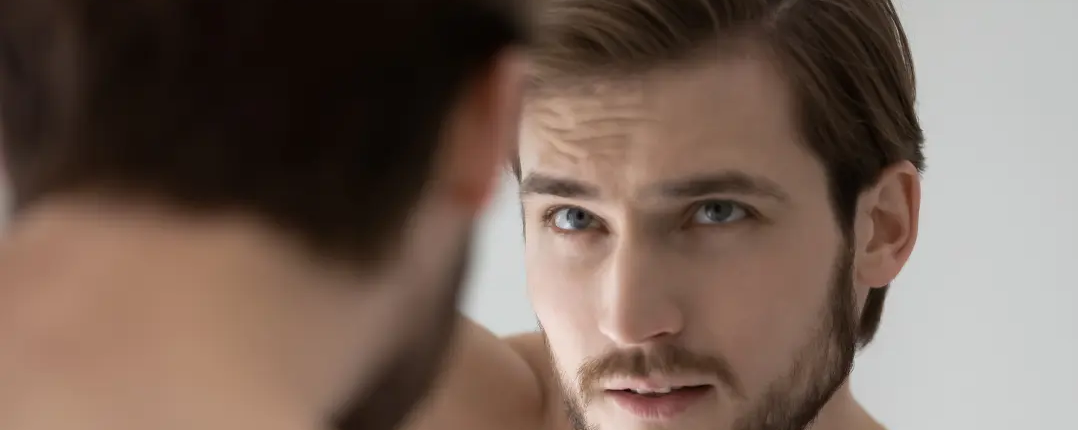Embracing Change: The Truth About Mature Hairline
Introduction
Have you noticed a change in your hairline lately? Maybe your friends or family have mentioned your hair looks different? Don’t worry! What you’re experiencing might be a normal thing called a mature hairline. This article has all you need to understand this type of hairlines. We will explore why they happen what they look like, and even how to handle them. Let’s dive in and find out more!
What is a Mature Hairline?
A mature hairline is how our hairline changes naturally as we get older. Often, a grown-up hairline might look like a soft “M” shaped hairline or “V” (like a widow’s peak). It’s normal and doesn’t mean we lose our hair or go bald. The Hairline starts moving back around 0.5-1 inch (1 to 2 centimeters) from the actual position(aka juvenile hairline) over many years. This process is known as a maturing hairline. This shift occurs between 17 and 30, driven by hormones and marking a subtle yet significant step into adulthood. This shift affects up to 50% of men and 25% of women by the age of 50, causing thinning and changes in the entire hairline. Knowing about a maturing hairline and its changes is crucial, especially for those facing hair loss or shifts in their hairline. It also marks the beginning of a new hairline, which can be a significant change for many individuals. Only 5% of caucasian men will carry their juvenile hairline into full adulthood.
A mature hairline is natural as you age during adolescence. This isn’t the same as male pattern baldness. Male pattern hair loss, or androgenetic alopecia, happens due to dihydrotestosterone (DHT) sensitivity. This androgen hormone leads to gradual hair loss and hair thinning, including a receding man’s hairline. It’s crucial to figure out if a man’s hair changes naturally with age or if it’s due to hair loss. It usually starts with the hairline moving back and hair getting thinner on top of the head. Unlike baldness, where hair gets thinner, a mature hairline is a change in how our hairline looks.
Understanding How a Mature Hairline Develops!
Exploring how our hair grows and changes, understanding mature hairlines. Our hair’s position is a mix of genes and hormones that control its growth. As we age, hormone levels change, causing front hair thinning.
A mature hairline is often determined by genetic factors, as well as hormonal balance. A family history of baldness is usually associated with a higher risk of developing male pattern baldness. Male hormones can make hair follicles too sensitive, leading to a receding hairline. The timing of hair loss often follows a similar pattern from one generation to the next. Some genes can make hair follicles sensitive to DHT, making it more likely for a mature hairline to show up.
Our hair is mainly keratin, produced by keratinocytes in follicles. These cells are like the architects behind our hair, making it grow and keeping it healthy. But as time passes, these workers might slow down, making our hair grow slower. That’s why some notice their hair thinning or the hairline moving back as they age. This slowdown can make hair follicles shrink, reducing the number of hair follicles available over a lifetime. It mainly affects the hairline, causing this type of hairline.
Why do our hormone levels change and affect our hairline?
Hormones act as conductors in our body, like dihydrotestosterone (DHT). It has a strong effect on our hair. DHT comes from testosterone. It attaches to hair follicles, making them shrink and produce thinner hair Hair loss happens when DHT sensitivity increases, leading to a faster rate of hair loss. Medications like finasteride, and minoxidil help slow it down. They can even prompt hair regrowth in balding areas. In two one-year trials, men using finasteride and minoxidil saw new hair growth. It increased significantly in balding scalp areas.
What does a maturing hairline look like?
So, how can you tell if your hairline is maturing? Well, there are a few telltale signs to look out for, including a slight recession of the hairline, particularly in the temple area. Hair loss often starts with an M-shaped receding hairline. Then, hair thins on the crown, sometimes leading to total baldness. This is one of the early signs of a mature hairline, which can also cause more hair loss on one side of the head than the other. You may also notice that the gap between your hairline and the highest wrinkle on your forehead is 1 or 1.5 inches. You may also notice that your hairline becomes more rounded or forms a gentle “M” shape. An early sign is vellus hairs, short, fine, almost transparent. They’re found along the hairline sometimes. These hairs are a normal part of the hair growth cycle and are not a cause for concern.
When Does Your Hairline Change?
A mature hairline often appears in the late teens or early twenties, during the teenage years. However, it’s important to note that everyone is different, Some might see it earlier or later in life. If you’re unsure about your changing hairline, consult a dermatologist.
Why does the hairline mature?
There isn’t a single, definitive cause of it. Instead, it’s a combination of genetic factors and hormonal changes. As we age, our hormone levels naturally fluctuate, which can affect the hair growth cycle. If you have a family history, You may be more likely to develop one yourself.
What is a Widow’s Peak?
You may have heard of the term “widow’s peak” in relation to hairlines. A widow’s peak refers to a V-shaped point in the hairline at the center of the forehead. It is often associated with individuals who have inherited a specific genetic trait. While a widow’s peak can sometimes be mistaken with this type of hairline, they are not the same thing. This is a more gradual recession of the hairline, while a widow’s peak is a distinctive point in the hairline shape.
How Long Does a Mature Hairline Last For?
The duration can vary from person to person. For some individuals, this may stabilize and remain unchanged for many years. For others, the recession of the hairline may continue slowly over time. It’s important to remember that this type of hairline is not a sign of hair loss or baldness, and it is normal and natural. If you’re losing hair after 30 or noticing stage 3 balding, it might be a sign of male pattern baldness, a usual issue for men. With the Norwood Scale, you can check your hair loss stage. It helps identify if your recession falls within its seven stages. Stage I shows no hair loss. Stage II shows a maturing hairline. Stages III-VII show significant recession, leading to balding.
Spotting the Difference: Mature Hairline vs. Male Pattern Baldness
1. Male Pattern Baldness :
This condition is also called androgenetic alopecia. This type of hair loss affects the entire scalp.
Usually kicks off with a signs of receding hairline, then moves on to thinning at the top of the head. You may notice excessive hair shedding.
2. Mature Hairline – Not the Same Story:
Unlike baldness, a mature hairline doesn’t come with thinning hair or bald spots.
It’s more about a shift in how your hairline looks without losing lots of hair.
3. Why It Matters to Know:
Understanding these differences helps in getting the right help.
Explore more about these two types of hairlines in our informative “Mature Hairline vs. Receding” article.
How to prevent your hairline from maturing?
1. Natural Process: A maturing hairline is a normal part of aging, and there’s no guaranteed way to stop it.
2. Healthy Diet: Nutritional deficiency can affect both hair structure and hair growth. It is important to consume a balanced diet. Eat well, exercise, and manage stress for hair follicles and health.
3. Gentle Care: Use mild hair products, and limit heat styling. Also, shields your hair from harsh chemical elements.
4. Expert Advice: If concerned, chat with a dermatologist or trichologist for personalized help.
5. Hair loss treatments can help to delay the progression of a mature hairline.
6. Hair restoration is a common choice for those with hair loss or maturing hairline.
Conclusion:
A maturing hairline is a natural part of aging and shouldn’t worry you. It involves a slight change in the hairline’s position or shape. While you can’t stop or turn back it, taking care of your hair and consulting experts may help.
At Genehabit, we know how hair loss can affect your confidence and life quality. That’s why we provide the HairLife hair loss DNA test. This test offers personalized solutions and identifies potential risks for hair loss.
Frequently Asked Questions
Can a mature hairline lead to baldness?
No, a mature hairline is not a cause of baldness. It is simply a change in the shape or position of the hairline and does not involve significant hair loss.
Are there any medical treatments for a mature hairline?
There are currently no medical treatments specifically for a mature hairline, as it is a natural part of the aging process. Although, if you experience hair loss, it’s best to consult with an expert.
What is a juvenile hairline?
The juvenile hairline tends to have a gentle curve at its edges and appears straight across the forehead.
How can you tell if your hairline has matured?
If the highest wrinkle on your forehead sits within your hairline. You’ve likely reached maturity.
Can Hair Transplants Reverse a Mature Hairline?
It depends on the severity of your hair loss and the type of mature hairline you have.
Book a consultation
Simply fill in your details in the form below and we’ll get in touch with you shortly.




